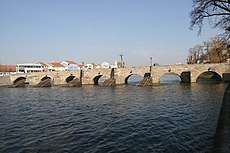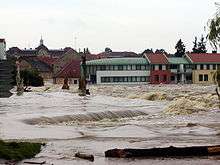Písek Stone Bridge
The Písek Stone Bridge (Czech: Kamenný most v Písku) is the oldest preserved early Gothic bridge in the Czech republic and by its originality, although deprived of its dominants, which formed its tower with gates, is one of the rarest medieval bridges in Central Europe.[1] It is located in the south Bohemian town of Písek. It was probably built in the 3rd quarter of the 13th century.

The bridge has been on the list of the Czech cultural monuments since 1989, becoming a national cultural monument in 1998.[2]
It is sometimes called the Stag Bridge because, according to legend, it was to be named after the first being to pass over it. At the time, Písek was surrounded by deep woods, so the first being to cross the bridge was a stag. However, most local people still call it the Old Bridge (starý most).[3]
It spans the Otava River, a tributary of the Vltava River.
The length of the bridge is 109.75m and the width 6.25m. It is built on six pillars and has seven arches and gives the impression of a "small" Charles Bridge.[4]
The bridge became an important link on the Golden Trail , which connected the Baltic areas with the Mediterranean and imported salt from Bavaria to the Písek salt store.[5]
Structure
The bridge was probably built in the 3rd quarter of the 13th century during the reign of Přemysl Otakar II.[6] Interestingly, it was built on dry ground. Only after its completion was the river redirected to a new trough, which passed under the bridge.[1]
The bridge is 109.75 m long and 6.25 meters wide, of which the roadway is 4.5 m. The bridge stands on 6 pillars and consists of 7 arches. Six arches are original. The seventh arch, with a double span width, was added in 1768 and served for the raft passage (timber used to be pulled down the river). Two towers guarded the bridge, one on each side. Unfortunately, none of them has survived. The first collapsed during the 1768 flood and the second was deliberately torn down in 1825 due to the growing transportation demands. Their fragments, salvaged from the river bottom, are on display on the left river bank near the bridge.
Sculptures
Originally, the bridge was without a sculptural decoration[7]. Today, replicas of baroque sculptures are lining the bridge. Their sandstone originals can be seen in the Prácheň Museum. There are four sculptural groups:
- Calvary dates from the 18th century and was sculpted in the Jan Hammer workshop . Statues of the Virgin Mary, Mary Magdalene and the Apostle John are arranged around a 6-meter high Cross with Christ. Replicas come from 1997.
- John of Nepomuk with two angels - original by an unknown author
- Saint Anne original - original dates from 1770
- Saint Anthony of Padua - original dates from 1770
Bridge Statues
.jpg) John of Nepomuk with Pisek's coat of arms
John of Nepomuk with Pisek's coat of arms- Saint Anthony of Padua (1770)
- Calvary
- Saint Anne (1770)
- Christ on Cross
- John of Nepomuk
- Angel
- Angel
Floods

The bridge has been exposed to the onslaught of floods several times throughout the centuries, for example in 1432 and 1768. The most recent being the "thousand year flood" of 2002, when the Otava water level rose so high that it tore off a stone wall. Despite the current's fifty-fold increase in force, however, the bridge structure withstood the flood.[4] The flood water removed the railings and some statues. After the flood, town of Písek started a general bridge reconstruction. The railings and statues were repaired; copy of the lost statue was recreated and the structure was retrofitted with a net of concrete and iron tubes.The bridge repair was enabled thanks to a public fundraiser that spontaneously started after the flood[8].
Cyclone
On 20 January 2007 cyclone Kyrill damaged the Christ Cross, luckily, the statue itself was almost undamaged. During the cross restoration historical documents were discovered in two time capsules placed inside the cross. There was a report by sculptor Karel Vlačiha[1] about a repair the cross underwent between 1897 and 1899. The second report was related to the repairs done between 1957 and 1959. This report was accompanied with a period copy of Rudé právo, then a leading newspaper of the Czechoslovak communist party.[9]
References
- "translate - Google Search". www.google.com. Retrieved 16 September 2019.
- "Kamenný most v Písku - Památkový Katalog". pamatkovykatalog.cz. Retrieved 16 September 2019.
- webmaster@tyden.cz, TYDEN, www tyden cz, e-mail (21 March 2008). "Pobřeží města Písku". TÝDEN.cz (in Czech). Retrieved 16 September 2019.
- "Písek - Sightseeing - Stone Bridge, visitpisek.cz". www.visitpisek.cz. Retrieved 15 September 2019.
- Redakce (13 July 2015). "Písek: město na zlaté stezce" (in Czech). Retrieved 16 September 2019.
- "Zdroje knih", Wikipedie (in Czech), retrieved 16 September 2019
- "Kamenný most". Čtení z Písku (in Czech). Retrieved 16 September 2019.
- Kolářová, Libuše (14 August 2017). "Kamenný most byl symbolem obnovy" (in Czech). Retrieved 16 September 2019.
- "Písek :: Křižáci". krizacipb.webnode.cz. Retrieved 16 September 2019.
See also
- Charles Bridge, the second oldest bridge in the Czech Republic
External links

- Oldest bridge in the Czech Republic reopens
- Golden Trail in Bohemia
| Wikimedia Commons has media related to Písek Stone Bridge. |